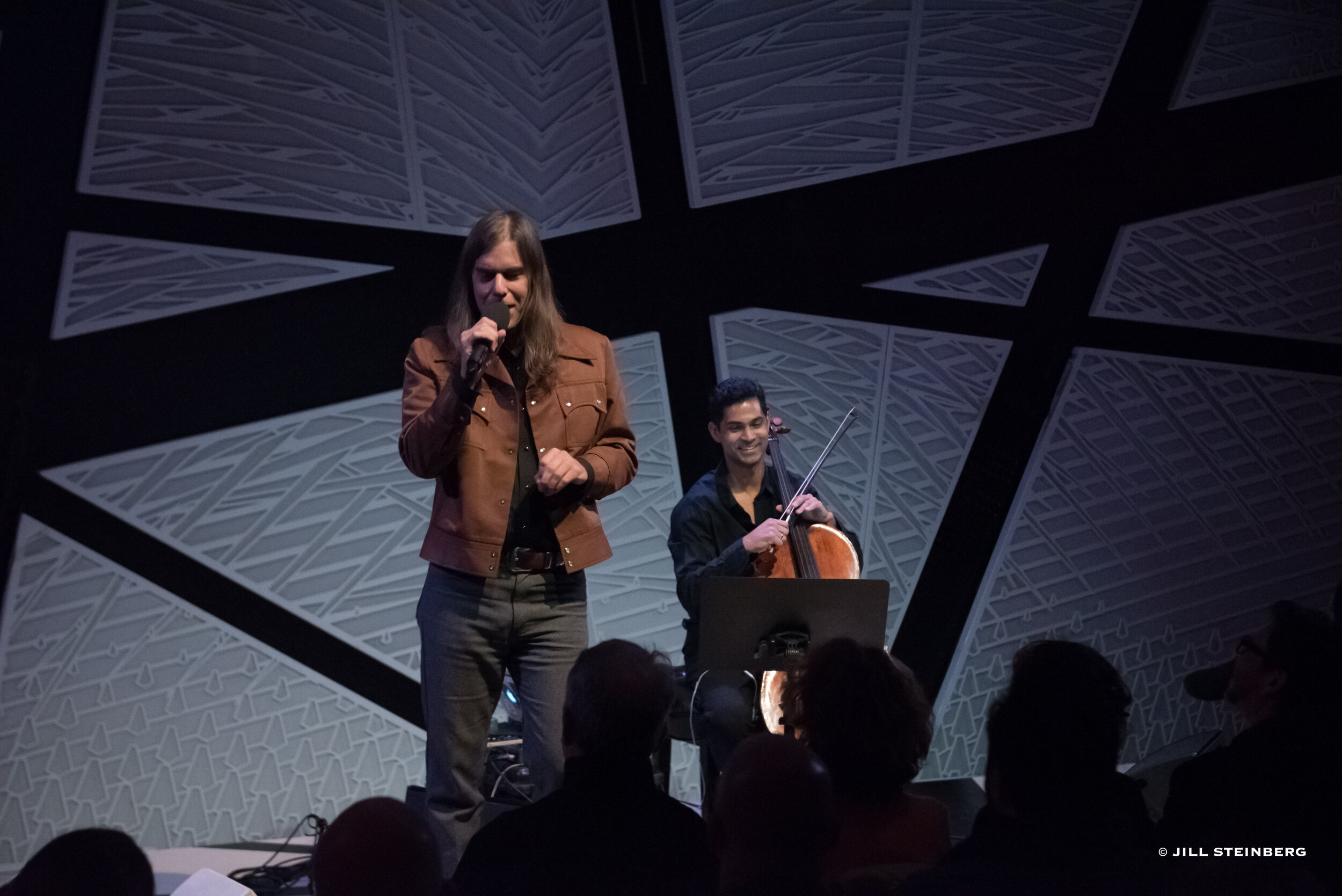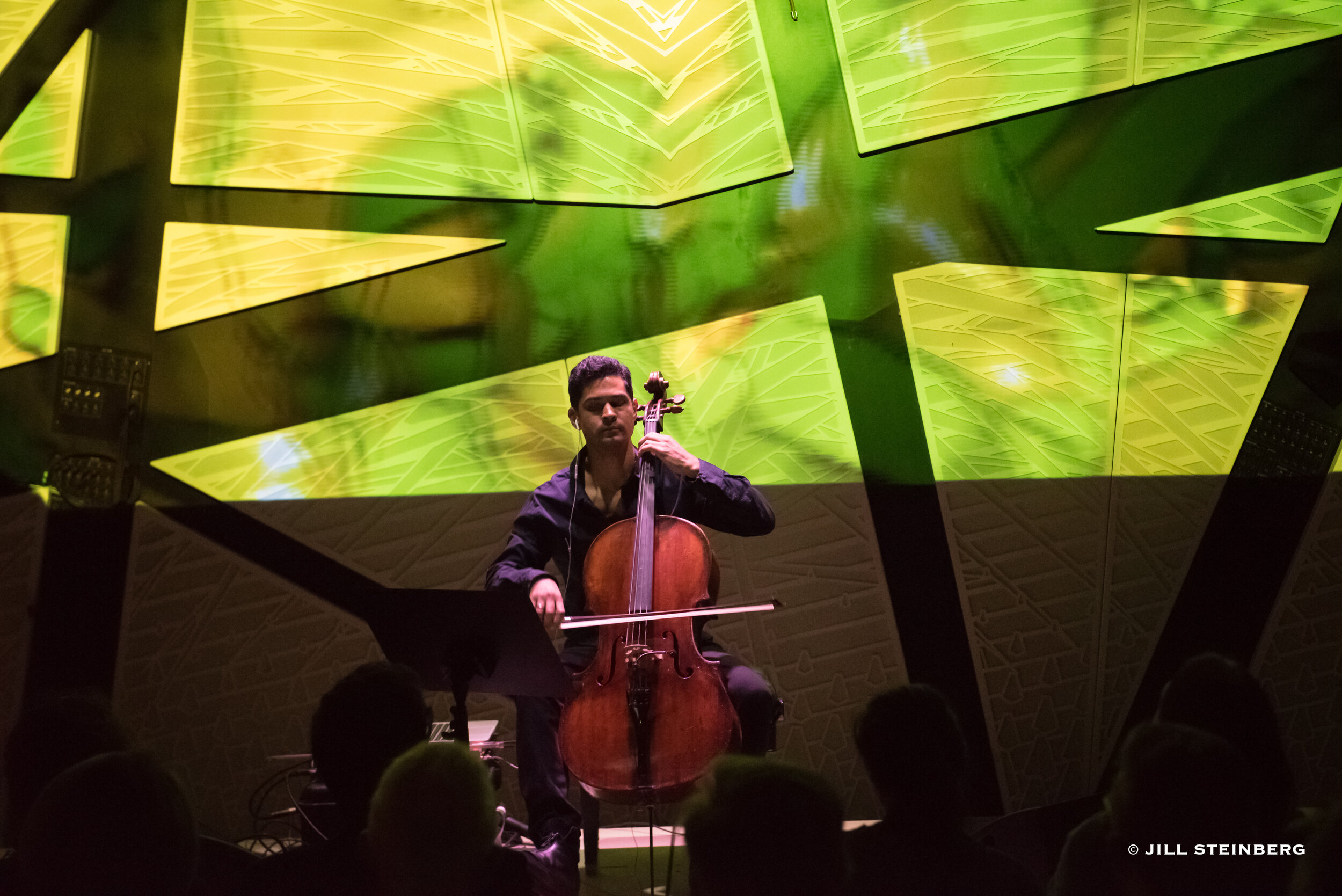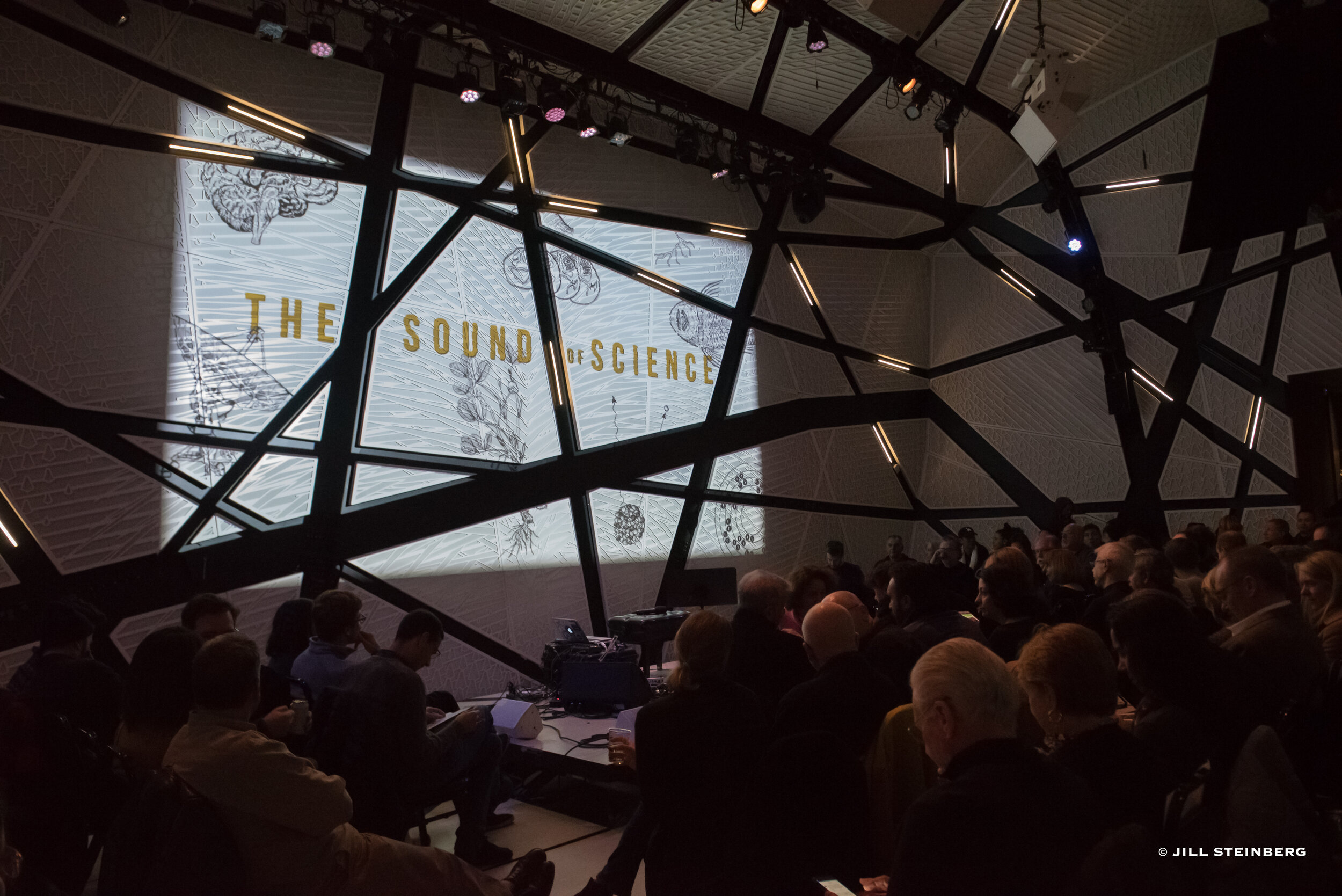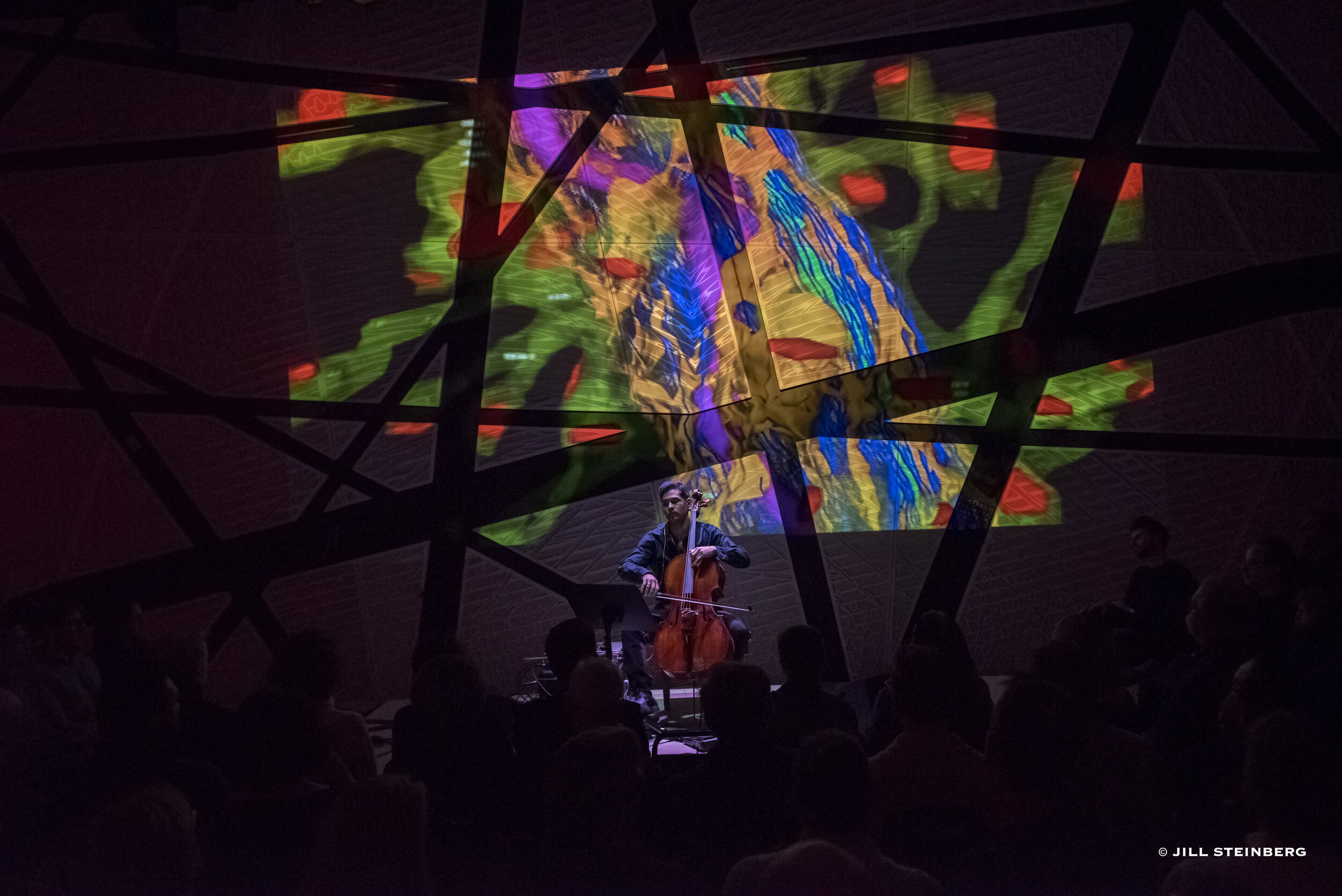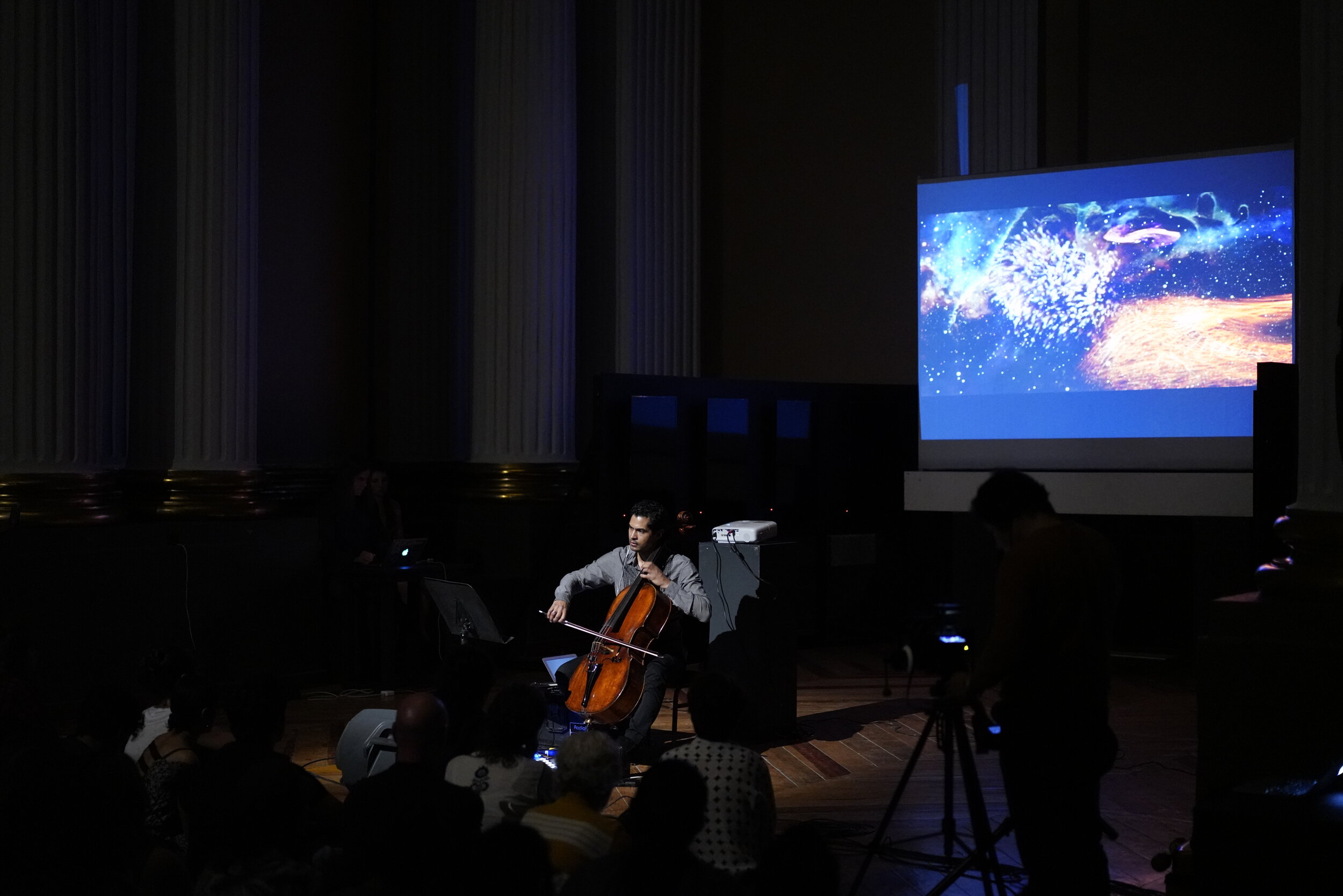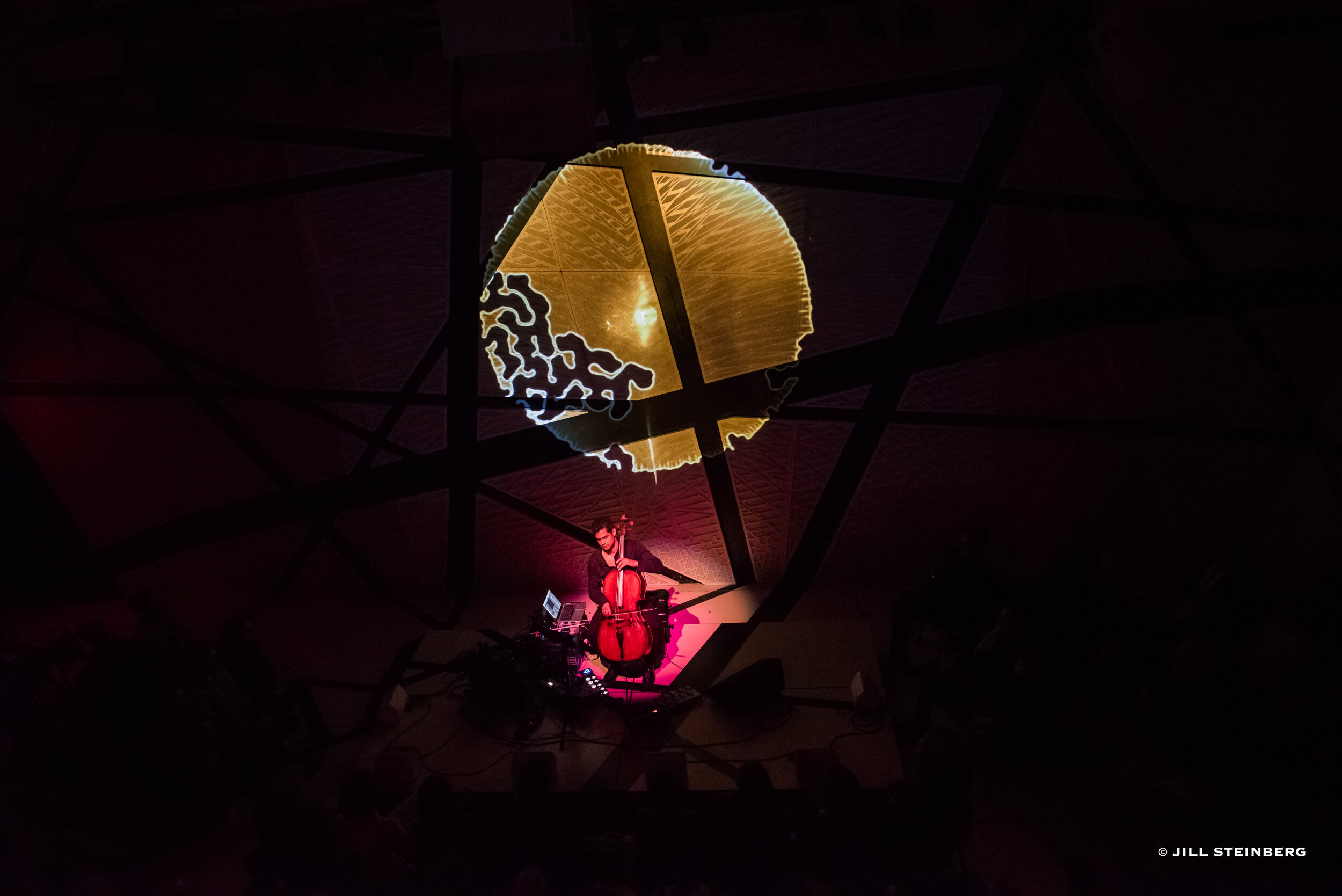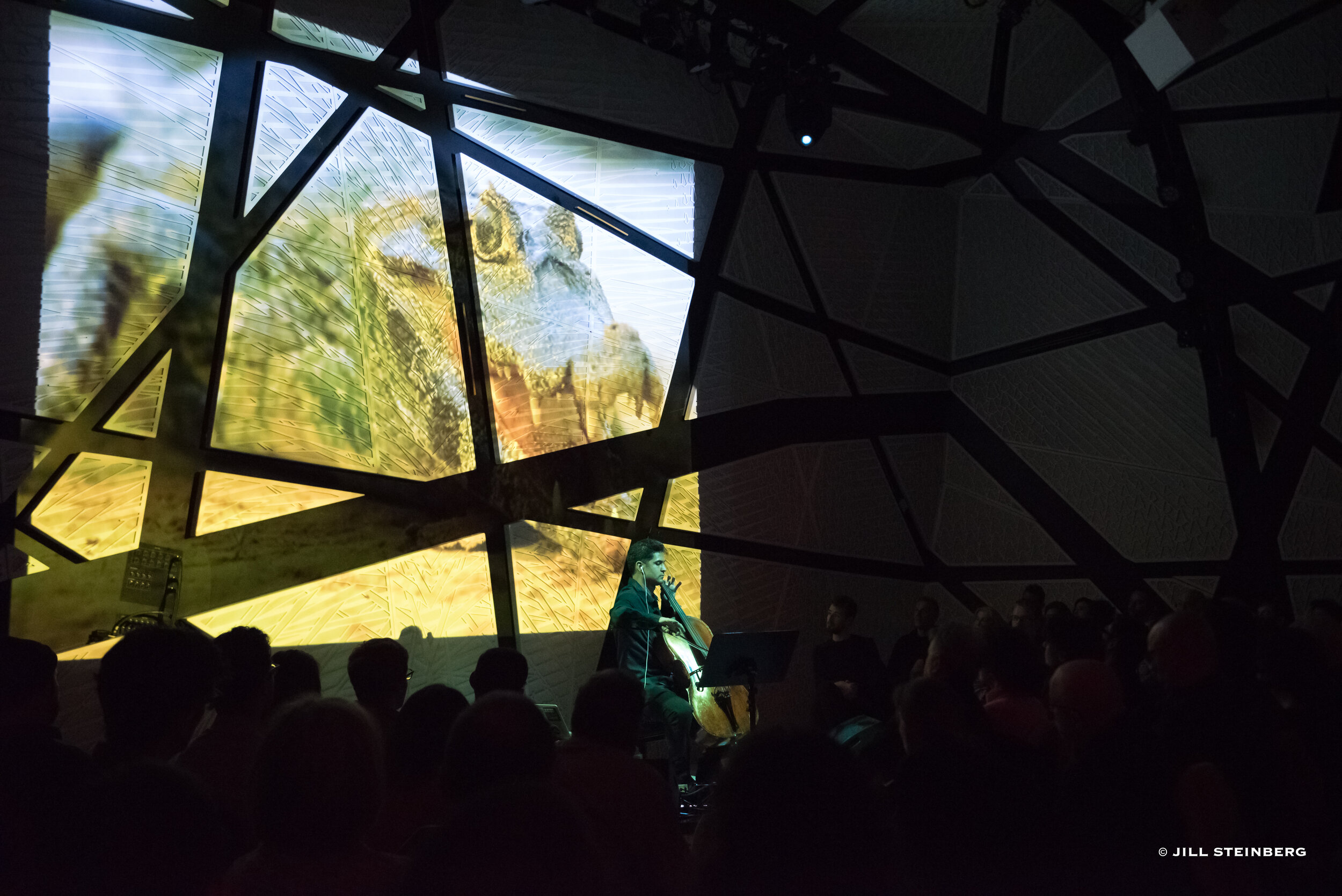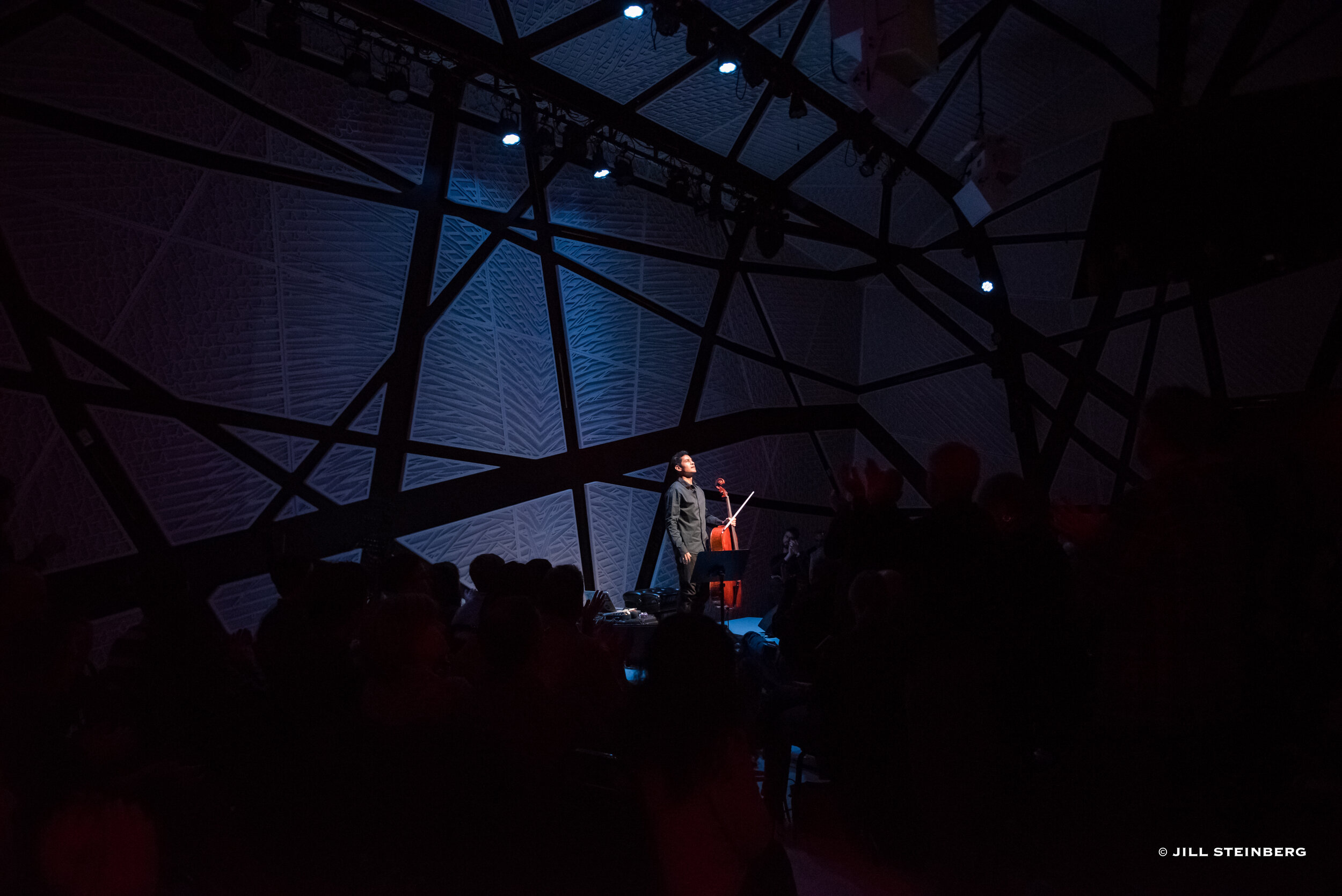TRACK LIST
GRAHAM REYNOLDS THE BRAIN
Sponsored by Eugene Sepulveda & Steven Tomlinson
SARAH LIPSTATE RADIATION IN MODERATION
PAOLA PRESTINI FROM THE BONES TO THE FOSSILS
FODAY MUSA SUSO SALUMBA
FELIPE PÉREZ SANTIAGO QUEST
Sponsored by Mike Chesser
MAJA S.K. RATKJE A HIGHWAY IN STATE SPACE
YUKA HONDA HER CONFIRMATION
GRAHAM REYNOLDS PASTAZA
The Sound of Science builds bridges between the musical and scientific worlds, celebrating their shared culture of inquiry.
“AN ALBUM YOU NEED TO HEAR NOW”
THE COMPOSERS | THE SCIENTISTS
FARMING AS A LIFE FORCE
Foday Musa Suso is an internationally recognized musician and a Mandingo griot - the historians and living libraries telling the stories of West Africa through both word and music. Born in 1950 and raised in rural Gambia - where he trained rigorously on the 21-stringed griot instrument called a kora - he relocated to the United States in the late 1970s, and soon after began collaborating with Herbie Hancock. He has since created and performed music with many others, including renowned composer Philip Glass and ensemble Kronos Quartet.
Suso grew up farming peanuts, the chief crop of his home country. In the year 1890, George Washington Carver initially enrolled in college as a major in art. Though a man of many disciplines - painter, crocheter, educator, baker and more - he switched to study agriculture and is best known for his role as a botanist and chemist. He is referred to as "The Peanut Man," for his creation of over 325 new products from the plant. This connection sparks a piece of music that celebrates Carver's life as well as the pair's shared appreciation for farming as a life force. Suso is delighted to tell Carver's story (raised as a free man by the couple who had enslaved his mother and older brother), and fuse it will the extensive verbal and musical heritage that can only be passed down within a Griot family; Foday is a direct descendant of Jali Madi Wlen Suso, the griot who invented the kora over four centuries ago. As Suso composes this piece on kora, the sounds he is hearing in his head are those of the peanut farm - particularly the small plink of a little hole being formed in the ground by his finger, the space for a seed to be planted. Read more about Carver's life, and Foday Musa Suso's life.
INTERSECTIONS OF HUMAN + CLIMATE
Paola Prestini is an “enterprising composer and impresario” (New York Times), whose music has been commissioned by and performed at Carnegie Hall, the Chicago Symphony, the New York Philharmonic, The Los Angeles Philharmonic, and more... all of which contribute to her being named one of the Top 35 Female Composers by The Washington Post. Her recent projects include The Hubble Cantata and The Colorado Project, among many others. She is also the founding CEO and Artistic Director of National Sawdust, a non-profit Brooklyn-based space for arts incubation and performance.
After hearing Prestini speak about National Sawdust on The Brian Lehrer Show in March 2016, Andrew Kruczkiewicz reached out. The two are now working as both scientific and musical collaborators, looking at the climate's natural variability and various parameters as well as the future and significance of data currently being collected. As a part of the International Research Institute for Climate and Society at Columbia University,
Kruczkiewicz's work in the field of climatology includes developing algorithms to detect and map patterns of precipitation, temperature, and other climatic variables, and analyzing their impact on agriculture and public health. In this way, he focuses on the intersection of the social and physical sciences, especially pertaining to early warning systems for extreme events such as floods, storm surge from tropical cyclones, wildfires and landslides. He is a drummer, and for the past three years has been experimenting with ideas of climate and music, including a project with the International Red Crescent Society to develop innovative approaches to communicate climate risk using music and tonality on a global scale. Prestini was drawn to connect with Kruczkiewicz for these reasons. She will be incorporating his words into the electronic tapestry of her work for this composition, with a particular focus on the hurricane patterns in the Caribbean. Read more about her interdisciplinary and innovative work Kruczkiewicz's bio.
SEARCHING THE COSMOS
Felipe Pérez Santiago is a Mexican composer, sound artist, conductor, and performer based in Mexico City. His work includes orchestral pieces, opera, chamber music, electronic works and scores for films, dance, video and more. Santiago’ music has been performed and commissioned in over forty countries by internationally renowned ensembles such as the Czech National Symphony Orchestra, Dutch Chamber Choir, the Choir of Madrid, the Cello Octet "Conjunto Iberico," the Mexico City Philharmonic Orchestra, Kronos Quartet, and more. He is founder and artistic director of the Mal'Akh Ensemble, a formation that combines contemporary music with rock, free jazz, improvisation, folklore, and electronic music as well as multimedia. As a child, Felipe loved Carl Sagan's Cosmos, which mesmerized his young mind and continues to today.
Since meeting her in April, Felipe has been communicating with Jill Tarter. Tarter is an American astronomer who has spent the last forty years making strides in her field. Since the termination of funding for NASA's SETI (search for extraterrestrial intelligence) program in 1993, Tarter has served in a leadership role to secure private funding to continue the exploratory science. She is a co-founder and former director of the SETI Institute, a non-profit research organization whose mission is to explore, understand, and explain the origin and nature of life in the universe, and to apply the knowledge gained to inspire and guide present and future generations. Currently, she serves on the management board for the Allen Telescope Array, which, when fully realized, will simultaneously survey the radio universe for known and unexpected sources of astrophysical emissions, and speed up the search for radio emissions from other distant technologies by orders of magnitude. Felipe is fulfilling his lifelong fascination with the universe through the creation of music which incorporates her space recordings and honors her efforts in the search for extraterrestrial intelligence. Read more about Tarter's work.
HUMAN COMPUTERS
Yuka C. Honda is best known for the band Cibo Matto, which she co-founded with Miho Hatori in 1994 and in which she created a unique one-person-band sound by triggering samples 'live.' She has produced recordings by, as well as recorded and performed with, a wide range of musicians including Yoko Ono, Sean Lennon, Martha Wainwright, Laurie Anderson, Kimbra, and Nels Cline. She has released three solo albums, and, amidst various diverse and ongoing projects, she currently performs as a solo electronics artists under the name EUCADEMIX. Born in Tokyo, Honda spent parts of her childhood in Germany and Denmark before eventually landing in New York City. Her various international experiences growing up have had a major influence Yuka C. Honda’s on her music, in which her primary interest is in the integration of elements which may initially seem foreign. As such, her work naturally defies the concepts of genres, borders, and barriers.
Katherine Johnson, the NASA mathematician who computed Apollo 11's route to the moon, is well known for breaking down barriers. By age 13, she was attending high school and working with numbers several grades ahead of her. In college, she found her math mentor in Dr. Claytor, the third African American to earn a PhD in Mathematics. In addition to starting a family and serving the public as a teacher, Johnson sought out a position at the Langley lab for aeronautics in 1953. An African American woman entering her field in the mid-20th century, she is remarkably credited with numerous breakthroughs in celestial navigation, was often referred to as "The Human Computer," and known to have said "I love learning, it's an art and a science." Honda shares this love and is funneling this passion into the music.
RADIOACTIVE ISOTOPES
Sarah Lipstate is a composer and filmmaker actively involved in the creation of audiovisual experiences, from soundtrack scores to installations. Through her solo project Noveller, Lipstate handles the electric guitar as her muse, and summons a sonic palette so rich as to challenge the listener to conceive of how it's housed in a single instrument manipulated by a solitary performer. She has toured with Iggy Pop, St. Vincent, and many more, and joined the podcast Radiolab for their tour of "Apocalyptical," performing a live cinematic score for the show alongside Glenn Kotche (of Wilco).
Marie Curie was born in Warsaw, Poland in 1867. After a general education and some scientific training from her father, she began her practical study. While in college, she became a part of a student's revolutionary organization, sparking her departure from the Russian occupied portion of Poland. She eventually reached Paris in 1891, to continue her education at the Sorbonne, where she studied Physics and Math, and met her husband and scientific partner, Pierre. Among many "firsts" credited to her name, Curie was the first woman to receive the Nobel Prize. Overcoming obstacles in her male-dominated field, she developed the theory of radioactivity (and coined the term), discovered two new elements (polonium and radium), and invented a mobile radiography unit which provided X-ray services to field hospitals during World War I. She also conceived of techniques for isolating radioactive isotopes and using them in the treatment of cancerous neoplasms. After experiencing severe stomach pains in college, Lipstate underwent medical tests that involved ingesting food and liquids that contained radioactive isotopes and then waiting as a machine traced the path of the isotopes traveling through her body. Since this experience, a number of her creative works - both in film and music - have been inspired by radiation. She is awestruck by the glimpses below the surface that radiation provides, and aims to capture this sense of wonder for Curie's achievements in the piece she is composing.
INNER WORKINGS
Maja S.K. Ratkje of Norway is an active singer/vocalist, electronics performer, and engineer, as a soloist or in groups such as SPUNK and BRAK RUG. She creates music for performance, films, theatre, dance, and installations, often incorporating visual or text elements. Her compositions can be heard worldwide, as performed by the Ensemble Intercomtemporain, Oslo Sinfonietta, The Norwegian Radio Orchestra, BBC Scottish Symphony, Fretwork, Cikada, and many more. She has been a composer in residence for festivals such as Other Minds in San Francisco, Trondheim Chamber Music Festival, Nordland Music Festival, and more. Born in 1973 in Trondheim, Norway, Ratkje was raised in the constant presence of science papers and journals.
Her mother, Signe Kjelstrup, has been a Professor of Physical Chemistry since 1985, and currently serves as the Principal Investigator for PoreLab Center of Excellence at the Norwegian University of Science and Technology. Her works in irreversible thermodynamics concerns electrochemical cells, membrane systems, and entropy production minimization in process equipment - or, in other words - energy saving models such as fuel cells to help reduce the impact of human activity on the climate. Today, Maja and her mother often discuss their respective creative and scientific processes, and debate the responsibility for the outputs of art vs. science. Maja initially studied science at university, before choosing a life of contemporary music. This piece will not only afford her the opportunity to write a piece reflecting on the similarities and differences in this intimately personal relationship, but on the impact of her mother's work on the grander scale of humanity. It will specifically focus on energy dissipation, and her mother's hypothesis that a cell with minimum dissipations must have special supply and outlet systems, inspired by nature's own designs... like the nose of a reindeer! In both senses, the inner workings are what will come to life. Read more Maja, and Signe.
WHAT CAME BEFORE & WHAT'S AHEAD
Called "the quintessential modern composer" by the London Independent, Austin-based composer-bandleader-improviser Graham Reynolds creates, performs, and records music for film, theater, dance, rock clubs, and concert halls, with a wide range of collaborators across a multitude of disciplines. He recently scored Richard Linklater's Last Flag Flying, the Rude Mechs' Stop Hitting Yourself for Lincoln Center Theater, Ballet Austin's Belle Redux, and a multi-year commission from Ballroom Marfa, The Marfa Triptych, amidst many other projects. His Creative Capital Award winning work, Pancho Villa From A Safe Distance, a bilingual cross-border opera created with librettists Lagartijas Tiradas al Sol (Mexico City) and director Shawn Sides, is currently touring. The performance flits around the borderlands and explores what is remembered of an iconic man, the memories of whom inspire questions of what is fact and what is fiction. For Reynolds, culture is a collection of memories, and all art - music included - is all created from and defined by what we've experienced.
For more than two decades, Kristen Harris' laboratory has worked to elucidate the structural components involved in the cell biology of learning and memory. As a Professor of Neuroscience and Fellow at the Center for Learning and Memory at the University of Texas, she leads a team that pursues understanding of synaptic plasticity in the hippocampus, the part of our brain which drives memory and its connection to emotion. They have been among the first to develop computer-assisted approaches to analyze synapses in three dimensions through serial section electron microscopy... the resulting images serve to visualize the structure of the brain, which Harris presented at the World Science Festival, and which can also be viewed on Synapse Web.
A fellow leading researcher and educator, Barry Chernoff, is the Director of the College of the Environment at Wesleyan University. In between teaching courses in environmental studies, tropical ecology, aquatic ecosystem conservation, and quantitative analysis, Chernoff conducts research centered on the freshwater fishes of the Neotropical region, primarily those of the Amazon. He has led international teams on over thirty-two expeditions to twelve countries for work on conserving vital watersheds (read more about Chernoff’s work). Graham was drawn to Chernoff's work for its influence and importance on this grand scale... when it comes to considering what future we are creating, there is nothing more crucial than the planet, its limited resources, and how it will fare for generations to come. Both Harris and Chernoff are leaders in their respective fields, tirelessly working to prepare a new generation to continue their crucial studies. Through two pieces of music, Graham will be honoring both individual's abundant curiosity for the world around them, and examining the way in which their work influences our understanding of both what came before and what's ahead.
WE ARE GRATEFUL TO THE SUPPORTERS
WHO MADE THIS ENDEAVOR POSSIBLE
Co-Commissioners
Kathleen & Harvey Guion
- - -
Suzanne Deal Booth
Anonymous
- - -
Shalini Ramanathan & Chris Tomlinson
- - -
Eugene Sepulveda & Steven Tomlinson
Mike Chesser
- - -
Tim & Karrie League
Amy & Chris Holloway
Kathy Blackbird & Craig Hurwitz
Lorelei & Chris Calvert
Beverley Dale
- - -
Alamo Drafthouse
Ann & Scott Leist
Louise O'Connor
Gina & Shari Fant-Simon
Karin Richmond
- - -
and
Teresa Finney, Annie Burridge, Rob & Amy Lauer, Ed & Cathy McHorse, Kenneth Trice, Joseph Strickland,
David Quin, Ron Berry, Blake Trabulsi, George & Dona Reynolds, Peter Helf, Peter Bay & Mela Dailey, Naila Ismail, Sly Majid, Jane Elizabeth Madison, Ian Schoen, Cary Ferchil & Sherri Greenberg, Sally Hahn, Reed Arnos, Clive & Robbie Luke, Janine Ploetz, Arnaud Mathieu, Eugenia Simon, Noah Kagan, LB Deyo, Charlotte Jernigan, Valerie Vela, Anne Marie Cherry, Anita Prewett, Buzz & Cheryl Moran, Yvette Reynolds, as well as the regular contributors supporting Golden Hornet's work.
The Sound of Science was also supported in part by New Music USA. To follow the project as it unfolds, visit our project page.




